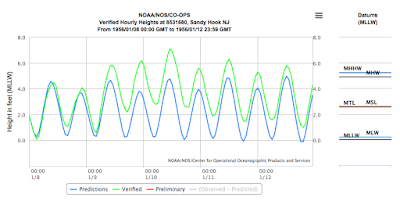Patricia's most destructive surge impacted a relatively small area, particularly around Barra de Navidad, a small community east of the hurricane's eye.
Patricia's most severe coastal impacts were felt in communities on bays to the east of landfall, such as Barra de Navidad.
Map created by Hal Needham.
One of the biggest coastal impacts was structural damage where storm surge and high waves crashed into buildings. A Weather Channel article provides direct quotes of surge flooding in coastal hotels:
-->(http://www.weather.com/news/weather/news/hurricane-patricia-mexico-pacific-coast-impacts).
Direct quotes:
"Residents of the coast where Patricia
came ashore described an enraged sea that crashed into hotels, scooping beach
away from their foundations, and howling winds that toppled trees and telephone
posts."
"'The waves were coming into the hotel,' said Domingo Hernandez, a watchman at the Hotel Barra de Navidad in the resort village of the same name in Jalisco state."
"'The waves were coming into the hotel,' said Domingo Hernandez, a watchman at the Hotel Barra de Navidad in the resort village of the same name in Jalisco state."
Storm surge and high waves crash into a structure along Mexico's Pacific Coast on Friday, October 23. Image: @atc26
Patricia's surge and high waves caused considerable damage in the Mexican state of Colima, east of Patricia's path.
Image: @Foro_TV on Twitter.
Image: @Foro_TV on Twitter.
Coastal erosion was another impact of Patricia's storm surge. According to @Foro_TV, storm surge and waves eroded 30-50 m (98-164 ft) of coastline near Barra de Navidad. See Twitter screen shot below.
Patricia's strong winds and surge caused a cargo vessel to run around near Barra de Navidad. According to 9 News Australia, helicopter rescue was needed rescue 27 crew members.
-->
Patricia's strong winds and storm surge drove a cargo vessel aground near Barra de Navidad.
Image and Info:
http://www.9news.com.au/world/2015/10/26/16/15/patricia-wedges-huge-cargo-ship-between-rocks
Some thoughts on Patricia's storm surge:
1. Although Patricia's storm surge was destructive for several coastal communities, the area impacted by the worst storm surge was relatively small. Several factors led to this pattern.
As the most vulnerable coastline faced southwest, prolonged east winds as Patricia approached were blowing offshore. The wrap-around winds on the backside blew surge and waves into coastal communities, but only those near the eastern eyewall. This can be contrasted to areas along the Texas and Louisiana coast in the U.S. that "catch" surge blown from east winds, which can pile up for more than 48 hours as a hurricane approaches. Also, the area of Patricia's hurricane force winds was relatively small, which led to a less extensive storm surge.
2. Storm surge is often very localized. Communities several miles apart sometimes experience very different conditions. Factors such as coastline shape and storm track often have strong influence on water levels. This is most pronounced near bays, inlets, delta systems or areas where levees, dikes or other flood control structures block the flow of water. Broad, "open" coastlines with less of these physical features tend to observe more consistent water levels. In Patricia's case, we should not be surprised that areas east of Manzanillo and the region near Puerto Vallarta did not experience high storm surges, while communities like Barra de Navidad experienced surge and waves crashing into hotels.
3. Fortunately, Patricia's track did not directly strike highly populated areas. This minimized surge and wave impacts. However, when storm surge strikes rural areas it often takes several days for pictures and videos to surface. Even then, we often need field teams to go into the impact zone and measure high water marks. It can take months for accurate scientific measurements to be compiled into a report that provides "official" documentation.
This is my last post on Hurricane Patricia. My thoughts and prayers are with people who live in the impacted area....let's hope for a strong recovery.


































